Have We Got Smoothies All Wrong?
How a ‘Smoothies Are Toxic’ claim sent me down a rabbit hole
Recently, the YouTube algorithm decided I need rescuing from my breakfast.
It keeps serving me a very earnest 'doctor' warning that “smoothies might be the most toxic drink known to man,” or words to that effect.
Usually, I'm laid back enough to shrug off that kind of clickbait. After the fifth repeat, I caught myself yelling at the iPad.
Here’s why it got…
Keep reading with a 7-day free trial
Subscribe to One Health Tweak a Week to keep reading this post and get 7 days of free access to the full post archives.




